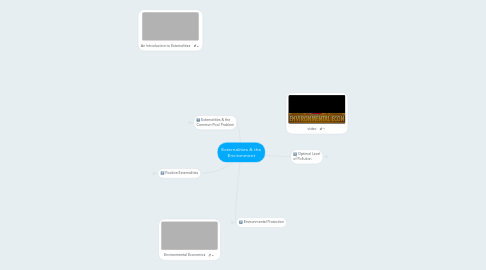
1. Externalities & the Common-Pool Problem
1.1. Exhaustible Resources
1.1.1. cannot renew itself
1.1.2. fixed supply
1.1.3. Coal, oil
1.2. Renewable Resources
1.2.1. Source that regenerates itself
1.2.2. can be used indefinitely when used conservatively
1.2.3. Common-pool Problem
1.2.3.1. unrestricted access to a renewable resource results in overuse
1.2.4. Private property rights
1.2.4.1. allow individuals to use resources or charge others for using
1.2.5. Common-Pool resources
1.2.5.1. Ocean fish
1.3. Resolving the Common-Pool Problem
1.3.1. Impose restrictions resource use
1.3.1.1. output restrictions or taxes
1.3.1.1.1. force use at a rate that is socially optimal
1.3.1.1.2. Ex: fishing restrictions on size & amount
2. Environmental Protection
2.1. Environmental Protection Agency (EPA)
2.1.1. established to solve the common-pool problems of air, water, and soil pollution
2.1.2. 3 categories of pollution control spending (% of spending)
2.1.2.1. air pollution abatement - 40%
2.1.2.2. water pollution abatement - 40%
2.1.2.3. solid waste disposal - 20%
2.1.3. Air Pollution
2.1.3.1. Clean Air Act of 1980
2.1.3.1.1. congress can set standards for the amount of pollution that can be released into atmosphere
2.1.3.2. smog
2.1.3.2.1. most visible form of air pollution
2.1.3.2.2. 40% comes from auto emissions
2.1.3.2.3. 40% comes from consumer-oriented products
2.1.3.2.4. 15% come from manufacturing
2.1.3.3. In the US, pollution on average is lower outside than inside
2.1.3.4. Greenhouse Gases
2.1.3.4.1. to fight climate change
2.1.3.4.2. The US & China account for >40% of emissions
2.1.4. Water Pollution
2.1.4.1. 3 main sources
2.1.4.1.1. sewage
2.1.4.1.2. chemicals
2.1.4.1.3. oil
2.1.5. Hazardous Waste & the Superfund
2.1.5.1. Superfund Law of 1980
2.1.5.1.1. requires any company that generates, stores, or transports hazardous wastes to pay to clean up any wastes that are improperly disposed of
2.1.6. Solid Waste: Paper or Plastic?
2.1.6.1. US households generate 4 lbs. of garbage per resident per day.
2.1.6.2. @ 70% of US garbage is bulldozed and covered with soil in landfills.
2.1.6.3. Recycling
2.1.6.3.1. process of converting waste products into reusable material
2.1.6.3.2. @ 1/2 US households participate in recycling programs
2.1.6.3.3. only @ 15% of US garbage gets recycled
2.1.6.3.4. 2 out of 3 aluminum cans get recycled
2.1.6.4. @ 15% of garbage gets incinerated
3. Positive Externalities
3.1. occur when consumption or production benefits other consumers or other firms
3.2. Ex: vaccinations, public education
3.3. Positive externalities of education:
3.3.1. better citizens
3.3.2. better able to support themselves
3.3.3. reduces probability of incarceration
3.3.4. Marginal Social Benefit
3.3.4.1. includes all the benefits society derives from education, both private & external
4. Environmental Economics
5. An Introduction to Externalities
6. Optimal Level of Pollution
6.1. External Costs with Fixed Technology
6.1.1. Fixed-production technology
6.1.1.1. when the relationship between output & generation of an externality is fixed
6.1.1.1.1. only way to reduce externality is to reduce output
6.1.2. Marginal social cost
6.1.2.1. = marginal private cost + marginal external cost
6.1.2.2. Optimal level?
6.1.2.2.1. Point C: MSC=D(MR)
6.2. External Costs with Variable Technology
6.2.1. Variable technology
6.2.1.1. occurs when the amount of externality generated can be reduced by altering the production process
6.2.1.2. Ex: Goal is to find the most efficient level of pollution for a given amount of electricty
6.2.2. Marginal social benefit
6.2.2.1. = Marginal private benefit + Marginal external benefit
6.2.2.2. Effect of changes in costs/benefits of reducing greenhouse gases
6.2.2.2.1. Lower cost of reducing emissions
6.2.2.2.2. Greater benefit of reducing emissions
6.2.2.2.3. the lower the MC of reducing greenhouse gases, the cleaner the air
6.2.2.2.4. the higher the MB of reducing greenhouse gases, the cleaner the air
6.3. The Coase Theorem
6.3.1. as long as bargaining costs are low, assigning property rights will generate an efficient solution
6.3.1.1. regardless of which party is assigned the right
6.3.2. the efficient solution depends on which party can avoid the externality at the lower cost
6.3.3. when the number of parties involved is large, Coase solution may not work
6.4. Markets for Pollution Rights
6.4.1. Ex: sell permits to pollute at market clearing price
6.4.1.1. producers who value the discharge rights the most, end up with them
6.5. Pollution Rights & Public Choice
6.5.1. command-and-control regulations
6.5.1.1. were the norm prior to 1990
6.5.1.2. required polluters to introduce particular technologies to reduce emissions by specific amounts
6.5.2. economic efficiency approach
6.5.2.1. offers each polluter the flexibility to reduce emissions as cost-effectively as possible
6.5.2.2. firms with lowest costs of emissions sell permits to those with greater costs
